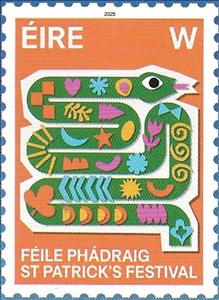Stamp: St. Patrick's Festival (Ireland 2025)
St. Patrick's Festival (Ireland 2025)
20 February (Ireland ) within release St Patrick's Festival (2025) goes into circulation Stamp St. Patrick's Festival face value W No Face Value
| Stamp St. Patrick's Festival in catalogues | |
|---|---|
| Colnect codes: | Col: IE 2025.02.20-01a |
Stamp is vertical format.
Stamp from souvenir sheet. Face value € 2.20 on day of issueAlso in the issue St Patrick's Festival (2025):
- Stamp - St. Patrick's Festival face value W;
- Stamp - St. Patrick's Festival face value W;
- Stamp - St. Patrick's Festival face value W;
- Stamp - St. Patrick's Festival face value W;
- Souvenir Sheet - St. Patrick's Festival face value 4*W;
Stamp St. Patrick's Festival it reflects the thematic directions:
A festival is an event celebrated by a community and centering on some characteristic aspect or aspects of that community and its religion or cultures. It is often marked as a local or national holiday, mela, or eid. A festival constitutes typical cases of glocalization, as well as the high culture-low culture interrelationship. Next to religion and folklore, a significant origin is agricultural. Food is such a vital resource that many festivals are associated with harvest time. Religious commemoration and thanksgiving for good harvests are blended in events that take place in autumn, such as Halloween in the northern hemisphere and Easter in the southern.
n Christian belief, a saint is a person who is recognized as having an exceptional degree of holiness, likeness, or closeness to God. However, the use of the term saint depends on the context and denomination. In Catholic, Eastern Orthodox, Anglican, Oriental Orthodox, and Lutheran doctrine, all of their faithful deceased in Heaven are considered to be saints, but a selected few are considered worthy of greater honor or emulation. Official ecclesiastical recognition, and veneration, is conferred on some denominational saints through the process of canonization in the Catholic Church or glorification in the Eastern Orthodox Church after their approval.In many Protestant denominations saint refers broadly to any holy Christian, without special recognition or selection.
Snakes are elongated, limbless reptiles of the suborder Serpentes Like all other squamates, snakes are ectothermic, amniote vertebrates covered in overlapping scales. Many species of snakes have skulls with several more joints than their lizard ancestors, enabling them to swallow prey much larger than their heads (cranial kinesis). To accommodate their narrow bodies, snakes' paired organs (such as kidneys) appear one in front of the other instead of side by side, and most have only one functional lung. Some species retain a pelvic girdle with a pair of vestigial claws on either side of the cloaca. Lizards have independently evolved elongate bodies without limbs or with greatly reduced limbs at least twenty-five times via convergent evolution, leading to many lineages of legless lizards. These resemble snakes, but several common groups of legless lizards have eyelids and external ears, which snakes lack, although this rule is not universal (see Amphisbaenia, Dibamidae, and Pygopodidae).




